WORKING IN THE LAND OF THE BUDDHA
Sharing life and faith with the people of Thailand
September 2002
Return to Table of Contents
Print Article
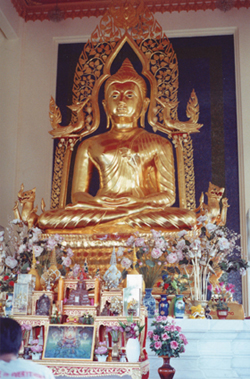
Thailand has a population of 67 million people. About 90 percent of the people are Buddhist and the Buddhist religion is integral to Thai life and culture.
In 1998, the Redemptorist Vocational School for the Disabled in Pattaya, Thailand, invited Scarboro Missions to send lay missioners to teach English to handicapped adults. The first Scarboro missioners arrived in January 2000 and there are now seven lay missioners in Thailand, two of whom are working in Bangkok.
Given that Buddhism is the majority religion of Thailand, the lay missionaries are getting lots of exposure to Buddhists and are honing their skills in interfaith dialogue.
In 2000, Georgina and Paddy Phelan became the first Scarboro missioners to work in Thailand. They were assigned to teach English at the Redemptorist Vocational School for the Disabled. In Thailand, February 8 is a public holiday and an important day in the Buddhist calendar, commemorating Buddha's sermon to 1,250 enlightened monks. On this special day, Georgina and Paddy's Buddhist students invited them to an early-morning ceremony led by Buddhist monks. Georgina recalls that experience:
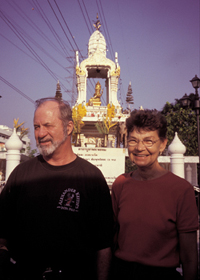
Paddy and Georgina Phelan, the first Scarboro missionaries to serve in Thailand, arrived there in January 2000. Both teach English at a school for physically handicapped adults.
We gathered in an open field and formed a large circle. When the seven monks arrived, we all knelt and the monks went around the circle collecting gifts of food from the students. One of the Buddhists whispered to me, 'You are the same as me? Buddha?' I shook my head to indicate no and he gave me a huge smile and a 'thumbs up'.
After the food offerings were collected, the monks began to chant. And what a beautiful and moving sound that was. Right then, something caught my eye. During the chant, a small yellow and white butterfly floated over the heads of the monks. The Holy Spirit was truly present.
After the ceremony, one of my students told me how happy she was that I had joined them for the prayer. Then she told me what the head monk had said in his opening remarks. He stated that today we are indeed one because the English teachers present at the ceremony are not Buddhist but Catholic. This made him very happy.
Sister Fernande Barnabe, a Missionary Oblate, is serving in Thailand as a member of Scarboro Missions. Sr. Fernande works at the Good Shepherd Sisters Women's Center in Pattaya. Below she shares an interfaith experience:
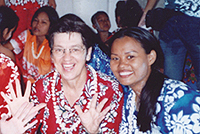
I was invited to attend the cremation of the husband of a woman who works at the centre. At the Buddhist temple crematorium, bouquets of flowers and a picture of the deceased were placed beside a beautiful red and gold coffin inside which sat the plain wooden coffin of the deceased.
The deceased man's eldest son had shaved his head, becoming a monk for at least one day to "make merit" for the deceased. (Merit refers to a good deed or an offering for the purpose of purification, for atonement, or in this case, in the hope of bettering the afterlife experience of the deceased.)
Removing the plain coffin, the monks tied a white string to it and all family members held onto the string. The coffin was then carried in procession around the crematorium three times while everyone chanted.
Before setting fire to the coffin, the family gave offerings including a robe, candles, incense and flowers to the monks. These offerings are also to 'make merit' for the deceased. Everyone present received flowers, which we threw on the coffin as it burned. All remained in a state of reverence until the smoke appeared in the chimney. If the smoke goes straight up, this is considered a good sign.
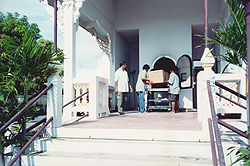
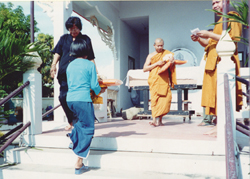
Photos above: Preparing for cremation at the crematorium. If the smoke goes straight up the chimney (top photo), this is considered a good sign for the spirit of the deceased person.
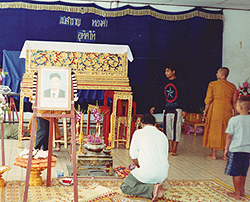
At the Buddhist temple and crematorium, the simple wooden coffin of the deceased sits inside an elaborate Buddhist coffin until cremation.
The relative responsible for carrying the picture of the deceased back to the family home was the first to leave the crematorium. As we left, no one looked back. Buddhists believe that this impedes the freedom of the deceased person's spirit to go into the next life. On the third or the ninth day after cremation, the spirit of the person is believed to visit the family home.
People in Thailand have a great respect for the Buddha and a strong belief in spirits. In every establishment there is a pagoda (spirit house) where people will come to offer flowers and incense.
Every morning on my way to Mass, I see people in humble prostration offering food to the monks. As well, they gladly give money in support of the temple and there are temples in almost every village. They adorn the statue of Buddha with garlands of flowers and offer incense, prostrating themselves in their offering.
I have a great respect for the Buddhist rituals. They are very similar to some Catholic rituals. I also value the respect Buddhists have for other faiths. They do not preach to others or try to convert others to their faith. As well, they are open to participating in our religious services. For example, many of the Buddhist women from our centres came to the funerals of two of the Good Shepherd Sisters here.
Scarboro Missions' Interfaith Desk on the Internet
To find out more about the interfaith work of Scarboro Missions, visit our website at www.scarboromissions.ca and click on Interfaith Dialogue.
Mission and Interreligious Dialogue website
The Mission and Interreligious Dialogue site of the Jesuits provides documentation on activities and ideas related to dialogue in Jesuit-related ministries in the United States. The web page also guides users to further Internet sites relevant to dialogue and the study of world religions. Go to:
http://puffin.creighton.edu/jesuit/dialogue/
Pope John Paul praises the ancient wisdom and nonviolence of Buddhism
During his visit to Thailand in 1984 the Pope was invited to a Buddhist temple. This encounter was followed by papal words of praise for the "ancient and venerable wisdom" found in Buddhism and "its special sensitivity to the renunciation of violence."
In 1995, John Paul toured Sri Lanka which, like Thailand, has a predominantly Buddhist population. In a speech delivered during this visit, The Pope asserted: "I express my highest regards for the followers of Buddhism with its four values of loving kindness, compassion, sympathetic joy and equanimity...I reassure everyone of the Catholic Church's desire for interreligious dialogue and cooperation."
Return to Table of Contents
Print Article